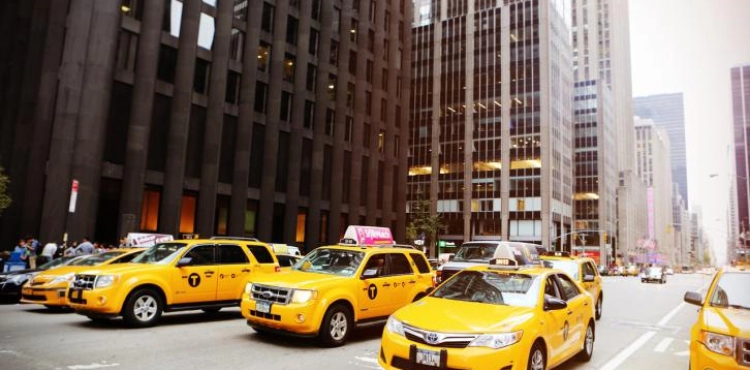Yellow taxis have for decades been one of the symbols of New York, after they were everywhere around the clock, but a year after the start of the pandemic, these vehicles are rare and their future appears mysterious.
These cars, which were seen everywhere day and night on the streets of the American business city, were symbolically equivalent to the importance of the Empire State Building or the baseball caps.
One February morning, about fifty yellow cabs were lined up near LaGuardia Airport in New York, patiently despite the biting cold, before loading a customer from one of the arrival gates.
“Hundreds of yellow taxis were lined up in this parking lot,” says Joy Olivu, who has worked for 30 years as a taxi driver, before the pandemic. “We were lining up in a long line and waiting for about 20 minutes. Today, we are about 50 cars, and we wait two hours.”
Due to telecommuting in business districts, school closures and the cessation of tourism, work has fallen as much for him as it is for all New Yorkers.
"It´s tough," says Olivo. "My income has decreased by 80%. I used to earn maybe a thousand dollars a week, but today I only make 200-300 dollars."
The 60-year-old man from Brooklyn, who maintained his cheerful mood despite everything behind the muzzle, adds that had it not been for his nurse wife who continues to "earn a good living ... I would have put a noose around my neck."
Free fall
But most taxi drivers in New York, the majority of whom are first-generation immigrants, are less fortunate and do not maintain a sense of humor in the face of the evaporation of their livelihoods.
Competition with Uber, Lyft, and other taxi-ordering apps has drastically affected their income, which could previously exceed $ 7,000 a month if they worked long hours seven days a week.
But with the epidemic, Richard Zhao, 62, from Burma, says his income is constantly declining.
But Chow isn´t the most desperate because he bought his license - called a "Medal" in New York - in 2006 for $ 410,000.
In the years that followed, the prices of licenses rose after a crowd of bankers, investors and lawyers bought them. In 2009, his younger brother Kenny Chow paid $ 750,000 for his license. And in 2014, it reached $ 1 million.
The success of Uber and others caused that "bubble" to burst and thousands of drivers who had bought their licenses with a high-rate loan went bankrupt or became in debt for life.
Kenny Chow committed suicide in 2018 like at least seven other drivers that year, and their suicide confirmed the tragic situation of the majority of these drivers.
In this context, the epidemic emerged and its "devastating effects," says Bayravi Desai, director of the Taxi Workers´ Alliance, a New York drivers association.
"Before the epidemic, demands decreased by 50%. Since the epidemic, we have approached 90%," she says. "And like the airports," the most desolate areas of the city are the neighborhoods of Manhattan that drivers depend on for their income. "
Cultural symbol
Hence the scarcity of yellow taxis, although there are about 13,000 licensed cars in the city, only 5,000 of them operate regularly at present, according to the union.
Around 7,000 drivers no longer take their cars out of the garage, as it is no longer profitable, says William Pierre, a Haitian driver.
Pierre continues to drive his car, although his daily earnings barely exceed $ 100 to $ 150 which he shares equally with the company that rents the car to him.
"I don´t want to stay at home. I want to go out and feed my family," he says.
Are the yellow taxis that replaced the taxis that were adorned with a strip of white and black squares in the 1960s, doomed to disappear?
Joey Olivu, like William Pierre, believes things will get better in the end, even if they agree that it "will never be the same again."
But Bayravi Desai fears it will "gradually disappear" if the city council does not write off the drivers´ debts.
Her union is pushing through the demonstrations. Dozens of drivers briefly interrupted traffic on the iconic Brooklyn Bridge last week.
You say, "You know you´re in New York when you see the yellow cab," because these cars are known all over the world. It is, as it says, "a cultural symbol ... and 24-hour service is an integral part of the economic, social and cultural fabric of this wonderful city."
Democratic New York Mayor Bill de Blasio promised to help taxi drivers on the condition that the federal government back the finances of the city drained by the epidemic.
"If we can get the incentive support we deserve. I think it will open the door to coming up with a solution to help taxi drivers and families who have suffered so much," he said Wednesday.
"We want to help the drivers, but we need (...) an assistance plan," he added.












